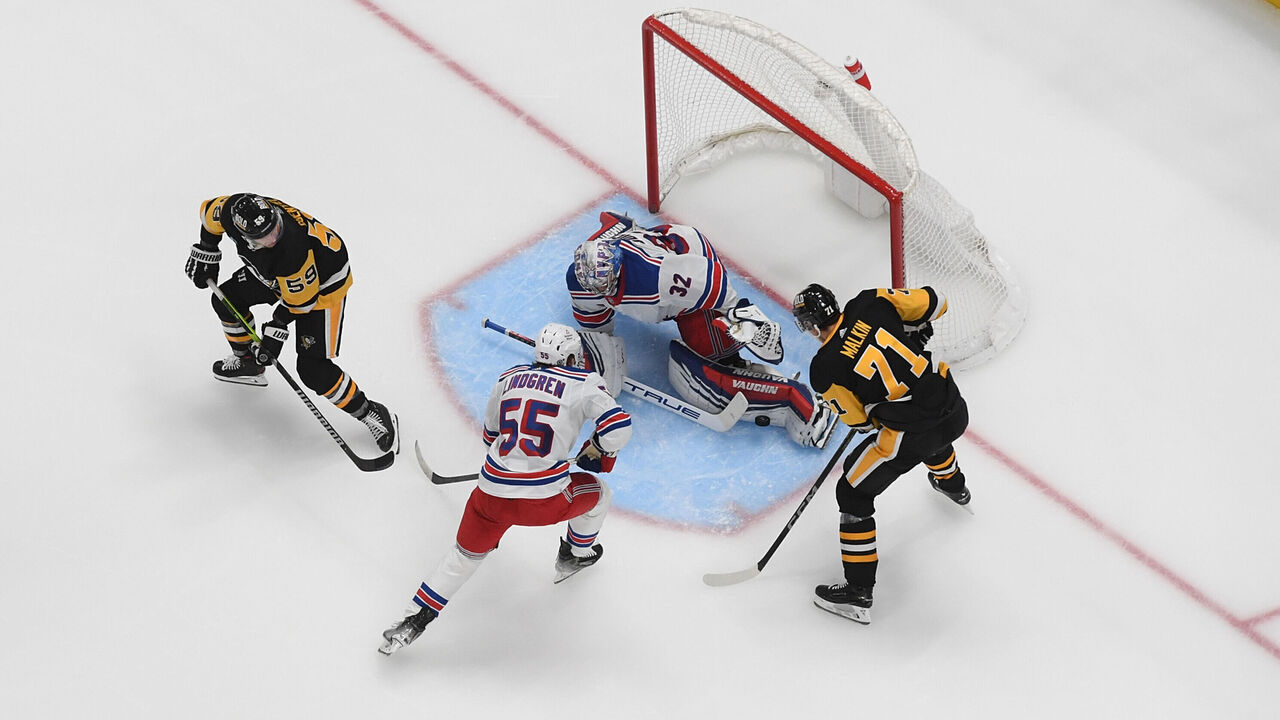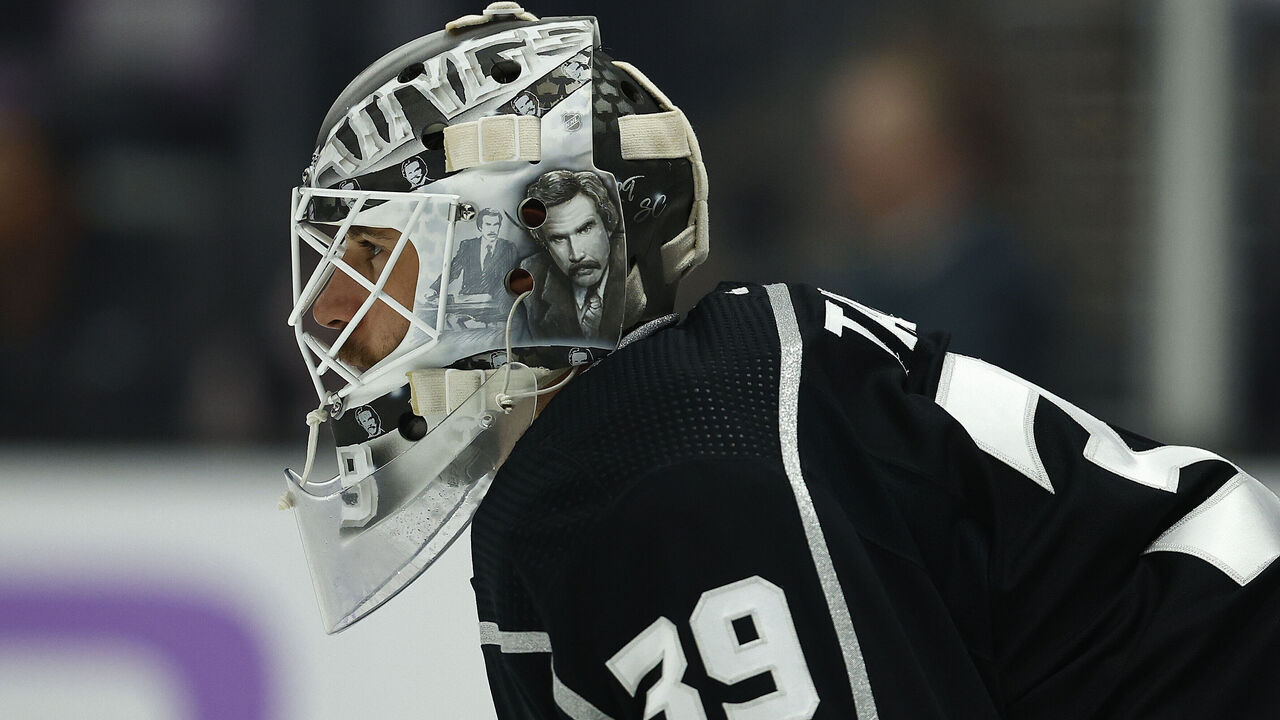The NHL passed the quarter mark of the 2023-24 season earlier this week.
As expected, goal-scoring continues to rule. The per-game average (6.3) is tied with 2022-23 and 2005-06 as the highest of the 21st century.
As expected, comeback wins are prominent. There were 62 third-period comebacks through Monday, tied for third-most at this stage of a season.
Expected is cool. Unexpected is better.
Let's check in on four unexpected trends at the team and player levels.
Pens' power play a mess

The Penguins last scored on the power play three weeks ago Saturday.
Over nine games, Pittsburgh's heavily used top unit, led by future Hall of Famers Sidney Crosby, Evgeni Malkin, and Erik Karlsson, has failed to convert on 21 man-advantage opportunities while allowing a goal against.
Overall, the Penguins have bagged only seven goals in 59 opportunities. Their 11.9% success rate - down 10 percentage points from last year - ranks 27th in the NHL.
It's perplexing given the personnel. The top unit also features Jake Guentzel, perhaps the most underrated offensive player of his generation, and one of Bryan Rust, Reilly Smith, or Rickard Rakell.
So, what gives? Just about everything.
For instance, in five opportunities against the Rangers on Nov. 22, Pittsburgh had trouble completing basic tape-to-tape passes and struggled to enter the offensive zone with control of the puck. When the Pens did manage to set up, New York predicted every move, leading to blocked shots and easy clears.
The zone-entry problem lingered against Toronto three days later. The Pens tried dumping the puck in, but penalty killers beat them on the retrieval. They tried to force seam passes high in the offensive zone - no dice.

One major theme throughout the 0-for-21 drought: the net-front guy is barely a factor. He often fails to take away the goalie's sightlines, and not enough pucks are getting to the net overall. The action's too much on the perimeter, making life easy on the penalty kill. There are no rebounds.
All that said, I don't think Pittsburgh's power play is hopeless.
The personnel's too talented to be this bad for a full season, and the 11-10-1 Pens are actually generating a decent amount of power-play offense. Pittsburgh ranks fourth in PP shot attempts per 60 minutes, fifth in PP shots on goal per 60, and second in PP expected goals per 60. Further: Pittsburgh ranks 30th in the league in total PP time. Drawing an extra penalty or two every game would relieve the pressure on each opportunity and, in a perfect world, help build momentum.
Each member of the top unit looks frustrated. They're probably overthinking it. If I were coach Mike Sullivan, I'd either sub in Kris Letang for Karlsson or have the star blue-liners co-run the top unit. Shuffling the deck is worth a try.
Reinhart pushing for Rocket
Sam Reinhart and Nikita Kucherov are currently tied for second in the NHL with 15 goals. Interestingly, Reinhart tops Kucherov and 17-goal man Brock Boeser in a different category: percentage of team goals scored.
Reinhart's scored 21.7% of all Panthers goals - a remarkably high rate 23 games into the season. (He has 13 assists, too.) The only player challenging for the Rocket Richard Trophy with a higher percentage than Reinhart is Frank Vatrano, whose 14 tallies account for 22.2% of Ducks goals.

Reinhart, a career 14.6% shooter, is hitting on an absurd 25.9% of his shots; he's skating a career-high 20:41 a game; and seven of his goals have been scored on the power play.
So, yes, Reinhart's 82-game pace - 53 goals, or 20 more than his previous best - is deceiving. He's riding the percentages a bit.
Still, the 6-2, 193-pound forward generally comes by his production honestly. He's a true master of the fundamentals.
Coaches at all levels instruct forwards to stop at the net at the end of a rush - Reinhart does this every single time. He's strong on his skates, takes very efficient routes in all three zones, and cycles the puck extraordinarily well.
He has what coaches call a "good stick," especially on special teams. He extends his stick into passing and shooting lanes on the penalty kill and, as shown in the clip below, subtly presents it to teammates on the power play:
14 goals for Sam Reinhart!
— Jameson Olive (@JamesonCoop) November 28, 2023
Barkov picks up his 400th career assist on the play. pic.twitter.com/DA1VMHYl7O
Also of note: Reinhart's name consistently shows up on leaderboards for individual expected goal and inner-slot shot generation, suggesting the 28-year-old often attacks from the offensive zone's most dangerous areas.
He does benefit from playing on a line with Aleksander Barkov, but that's true for anyone who skates with the Finnish center. Regardless, there's no denying Reinhart has asserted himself in the final year of a three-year deal carrying a $6.5-million average annual value. Time for a hefty raise.
Bruins dominating again

Projecting the 2023-24 Bruins wasn't an overly controversial process.
Impact forwards Patrice Bergeron, David Krejci, Taylor Hall, and Tyler Bertuzzi all departed, and the magic of last year's record-breaking regular season vanished, so Boston logically appeared ready to take a major step back. Making the playoffs in an improved Atlantic Division was certainly possible but not preordained.
Oh, how wrong - horribly wrong! - most of us were.
Boston's 15-4-3 with a plus-19 goal differential through 22 games. This year's team isn't quite as dominant as last year's, and has lost four of its past seven, but the Bruins mostly look like a Stanley Cup contender and currently hold the Atlantic's No. 1 seed.
As for where the consensus projection whiffed, let's start with the core.
Bergeron, arguably the greatest defensive forward of all time, was a massive loss. But two forwards (David Pastrnak and Brad Marchand), two defensemen (Charlie McAvoy and Hampus Lindholm), and two goalies (Linus Ullmark and Jeremy Swayman) are all either smack in the middle of their primes or near the end. We probably didn't give that enviable top of the lineup enough credit.
David Pastrnak with the zone entry and pass. Pavel Zacha with the finish.
— Evan Marinofsky (@EvanMarinofsky) December 1, 2023
3-0 Bruins: pic.twitter.com/PdB11WEboW
The coach is also still around, and Boston's been one of - if not the best - puck-support team in the NHL under Jim Montgomery. They worked in numbers on offense and defense all of last year and continue do this season.
We definitely underrated the quality of Boston's goalies and top-six centers. Having Ullmark or Swayman in net every game means the opposition never gets a break - an elite netminder for all 82 is a massive trump card in this shared workloads era. Meanwhile, Pavel Zacha (Pastrnak and Marchand's main center) and Charlie Coyle have filled in admirably for Bergeron and Krejci.
Lastly, the rookie class is notable. Five first-year players have appeared in 10 or more games and each is pitching in, led by forward Matthew Poitras. Teams of Boston's ilk don't usually receive a shot in the arm like that.
Talbot-Copley is all Kings need
The Kings opened the season with the least amount of money devoted to goaltending, with Cam Talbot and Pheonix Copley making a combined $2.5 million, or 3% of total cap dollars. I called it the Adin Hill Won the Cup Effect.
Talbot's cap hit this year ($1 million) is lower than Copley's ($1.5 million), though Talbot already secured a $1-million bonus by appearing in 10 games. L.A. will happily deal with that bonus charge on next year's cap sheet considering the value Talbot, 36, is offering right now.

Analytics company Sportlogiq awards a "quality start" whenever a goalie posts a positive value in its goals saved above expected metric. So far, Talbot has 10 quality starts in 14 tries. His .928 all-situations save percentage ranks second among 27 NHL goalies who've logged 700 or more minutes.
Including Copley's minutes, the Kings have the league's sixth-best team save percentage through 20 games. The .913 rate is a huge upgrade on last year's debacle between the pipes: an .889 rate that tied for 26th out of 32 teams and that was spread across four goalies, including two who made around $5 million.
What should be most encouraging is the play in front of Talbot and Copley. Coach Todd McLellan's skaters are on average surrendering very few shots, and the ones they do surrender tend to be from medium or long range. The skaters are insulating the goalies.
That lockdown style is conducive to winning in both the regular season and playoffs - as reigning Cup champion Vegas and Hill showed.
John Matisz is theScore's senior NHL writer. Follow John on Twitter (@MatiszJohn) or contact him via email (john.matisz@thescore.com).
Copyright © 2023 Score Media Ventures Inc. All rights reserved. Certain content reproduced under license.